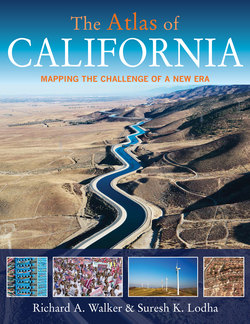Читать книгу The Atlas of California - Suresh K. Lodha - Страница 17
На сайте Литреса книга снята с продажи.
ОглавлениеLand & Nature
California is so distinct in topography, climate and ecology that it has been called “an island in the land”. Facing the Pacific Ocean on the west, it is walled off by high mountains in the north and east and by deserts in the south and southeast. Within that realm lie nine major topographic regions. Dominating the state’s midsection are three parallel regions: Coast Ranges, Central Valley, and Sierra Nevada. Southern California has three regions, as well: Coastal Plain, Transverse Ranges, and Mojave Desert. The Transverse Ranges run east–west, cutting across the grain of the Sierras and Coast Ranges. Northern California has two subregions: Klamath and Siskiyou Mountains on the west and the volcanic landscape of the Southern Cascades to the east. Beyond the Sierra, California shares a piece of Nevada’s Basin and Range. California’s landscape is a creation of the tectonics generated by the collision of the Pacific and North American plates. In the distant past, the Pacific floor dove under the continent, pushing up the Sierra (as in today’s Cascades). Now the Pacific plate slides along the San Andreas fault system, twisting northwest and pushing upward, creating the Coast and Transverse Ranges, and periodically shaking up California’s cities. California has benefited greatly from the gifts of the land: gold, silver, and other minerals left by volcanism and uplift; oil deposits from sea beds driven far beneath the coast; and deep valley soils deposited from ancient mountains.
California’s geography sets it apart from the rest of North America. Its natural blessings have been a source of wonder and wealth, its frequent earthquakes a challenge.
18
